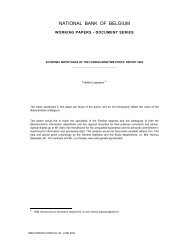Working Paper Research - Nationale Bank van België
Working Paper Research - Nationale Bank van België
Working Paper Research - Nationale Bank van België
You also want an ePaper? Increase the reach of your titles
YUMPU automatically turns print PDFs into web optimized ePapers that Google loves.
anks to the developing world (Borio and Toniolo, 2008, p. 63). Moreover, the statistics werepublished from 1974 onwards.The BIS data revealed the massive growth in indebtedness of certain countries as well as itsincreasingly short-term character, which was sowing the seeds of a crisis. In speeches he gave in1976, Lamfalussy had already drawn attention to the risks involved, "De mes trois premiers points -le développement continu (des crédits), l'extension des risques à un grand nombre de pays et lechangement dans la nature des crédits - je retiens la conclusion que le problème des risquesdevient urgent" 27 (Lamfalussy, 1976b, p. 5).Lamfalussy also emphasised that a borrowers' market had been developing. He argued that the"supply-led growth of international bank credit has led to a reduction of bank margins to the pre-Herstatt levels, to the lengthening of the maturity of bank loans and to the increase in the size ofindividual syndicated lending operations" (Lamfalussy, 1978, p. 4). For Lamfalussy, importantcauses of this borrowers' market were loose monetary policies and the US current account deficit,which was "pumping liquidity into the international financial system" 28 . So, a distinguishingcharacteristic of Lamfalussy's approach is that he placed debt problems in a broadermacroeconomic context, paying particular attention to the interaction of global imbalances and debtdynamics. Noteworthy, too, is that Lamfalussy was less concerned about potential inflationaryconsequences of these imbalances than about potential financial stability effects (just as he waslater, in the first decade of the 21st century, see Lamfalussy 2006).In the following years, Lamfalussy further emphasised potential financial stability implications of theborrowers' market. He argued that the increasing maturity transformation might "raise particularproblems for banks lending in currencies for which they do not have a widely spread, perhapsretail-banking, domestic deposit base" (Lamfalussy, 1979, p. 4). Moreover, he was concernedabout the adequacy of the equity positions of the banking system, "claims on specific individualcountries have reached in some banks - even in some banking systems - levels that are too high inrelation to their equity" (Lamfalussy, 1981, p. 7).5.2.2 Efforts at restraining the debt build-upWhen Lamfalussy arrived at the BIS in 1976, he launched the idea of setting up a "centrale desrisques" (risk office) there. His idea was that the 40 or 50 major commercial banks would submit,directly to the BIS, information on their claims to individual countries. The information would also27 "From my first three points - the continuous growth (of lending), the extension of risks to a large number ofcountries and a change in the nature of the loans - I draw the conclusion that the risk problem is gettingurgent."28 In a contribution to a March 1979 report, entitled "Major payments imbalances and international financialstability" (p. 56-59), for the Trilateral Commission (BISA, 7.18(25), LAM30/F77), Lamfalussy argued that,from end 1973 to mid 1976, international bank lending was highly beneficial and "anti-deflationary", as itdid not lead to a net increase in international reserves. However, from mid 1976 to end 1978, the pattern ofexternal imbalances changed, with an erosion of the OPEC surplus and a large US current account deficit,"an ample increase in net international liquidity in dollars, supplying too much of the wrong kind of liquidity"(original italics).11
















